CHEEK
BUCCAL
PERTAINING TO THE FINGERS
DIGITAL
SHOULDER BLADE REGION
SCAPULAR
ANTERIOR ASPECT OF KNEE
PATELLAR
HEEL OF FOOT
CALCANEAL
PERTAINING TO THE HEAD
CEPHALIC
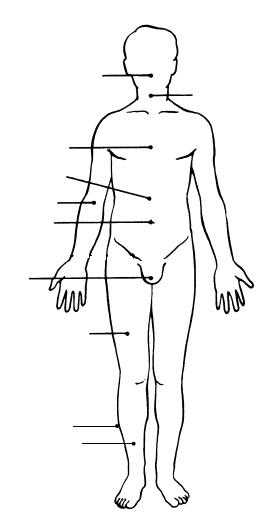
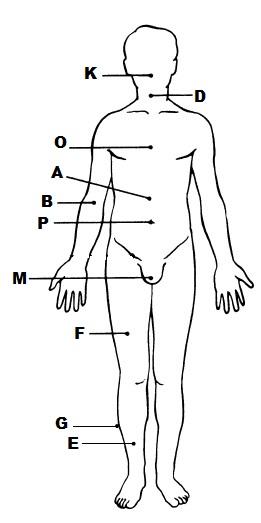
K. ORAL
D. CERVICAL
O. THORACIC
A. ABDOMINAL
B. ANTECUBITAL
P. UMBILICAL
M. PUBIC
F. FEMORAL
G. FIBULAR
E. CRURAL
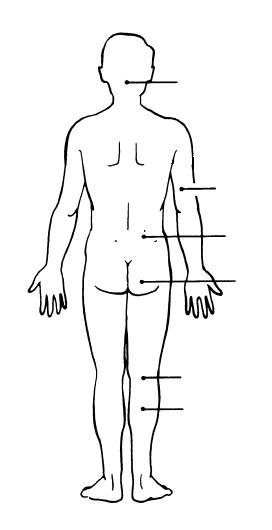
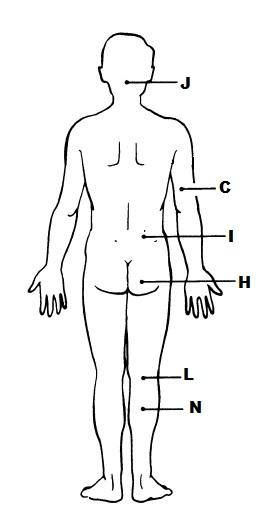
J. OCCIPITAL
C. BRACHIAL
I. LUMBAR
H. GLUTEAL
L. POPLITEAL
N. SURAL
CLASSIFY EACH OF THE TERMS IN THE KEY OF QUESTION 2 ABOVE INTO ONE OF THE LARGE BODY REGIONS INDICATED BELOW. INSERT THE APPROPRIATE KEY LETTERS ON THE ANSWER BLANKS.
1. APPENDICULAR ________________________________
B. ANTICUBITAL
C. BRACHIAL
E. CRURAL
F. FEMORAL
G. FIBULAR
H. GLUTEAL
L. POPLITEAL
M. PUBIC
N. SURAL
CLASSIFY EACH OF THE TERMS IN THE KEY OF QUESTION 2 ABOVE INTO ONE OF THE LARGE BODY REGIONS INDICATED BELOW. INSERT THE APPROPRIATE KEY LETTERS ON THE ANSWER BLANKS.
2. AXIAL _______________________________________
A. ABDOMINAL
D. CERVICAL
I. LUMBAR
J. OCCIPITAL
K. ORAL
O. THORACIC
P. UMBILICAL
DESCRIBE COMPLETELY THE STANDARD HUMAN ANATOMICAL POSITION.
IN THE ANATOMICAL POSITION THE HUMAN BODY IS ERECT, WITH THE FEET ONLY SLIGHTLY APART, HEAD AND TOES POINTED FORWARD, AND ARMS HANGING AT THE SIDES WITH PALMS FACING FORWARD.
DEFINE SECTION
A CUT, A PART OF THE BODY OR ORGAN THAT IS CUT TO BE ABLE TO OBSERVE/STUDY IT WITHOUT INCLUDING SURROUNDING AREAS.
In the anatomical position, the face and palms are on the (1) body surface; the buttocks and shoulder blades are on the (2) body surface; and the top of the head is the most (3) part of the body. The ears are (4) and (5) to the shoulders and (6) to the nose. The heart is (7) to the vertebral column (spine) and (8) to the lungs. The elbow is (9) to the fingers but (10) to the shoulder. The abdominopelvic cavity is (11) to the thoracic cavity and (12) to the spinal cavity. In humans, the dorsal surface can also be called the (13) surface; however, in quadruped animals, the
dorsal surface is the (14) surface.
1. ANTERIOR
2. POSTERIOR
3. SUPERIOR
4. SUPERIOR
5. MEDIAL
6. LATERAL
7. ANTERIOR
8. MEDIAL
9. PROXIMAL
10. DISTAL
11. INFERIOR
12. ANTERIOR
13. POSTERIOR
14. SUPERIOR
If an incision cuts the heart into right and left parts, the section is a (15) section; but if the heart is cut so that superior and inferior portions result, the section is a (16) section. You are told to cut a dissection animal along two planes
so that the kidneys are observable in both sections. The two sections that will always meet this requirement are the (17) and (18) sections. A section that demonstrates the continuity between the spinal and cranial cavities is a (19) section.
15. SAGITTAL
16. TRANSVERSE
17. FRONTAL
18. SAGITTAL
19. FRONTAL
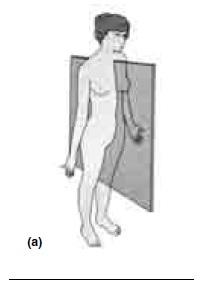
CORRECTLY IDENTIFY EACH OF THE BODY PLANES BY INSERTING THE APPROPRIATE TERM FOR EACH ON THE ANSWER LINE BELOW THE DRAWING.
MEDIAN (MIDSAGITTAL) PLANE
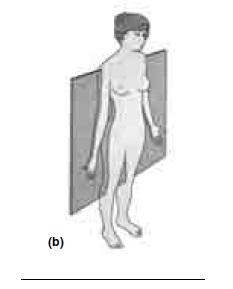
CORRECTLY IDENTIFY EACH OF THE BODY PLANES BY INSERTING THE APPROPRIATE TERM FOR EACH ON THE ANSWER LINE BELOW THE DRAWING.
FRONTAL PLANE
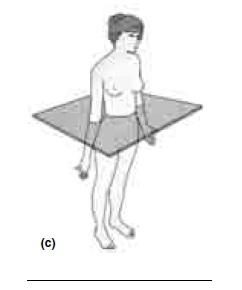
CORRECTLY IDENTIFY EACH OF THE BODY PLANES BY INSERTING THE APPROPRIATE TERM FOR EACH ON THE ANSWER LINE BELOW THE DRAWING.
TRANSVERSE PLANE

Draw a kidney as it appears when sectioned in each of the three different planes.
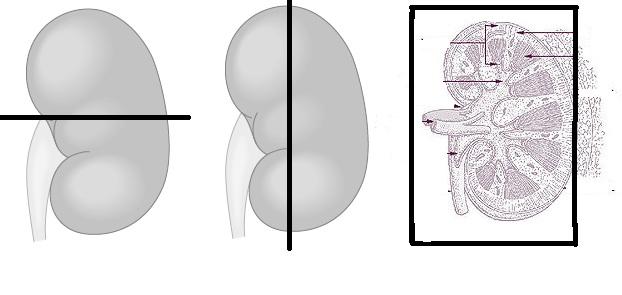
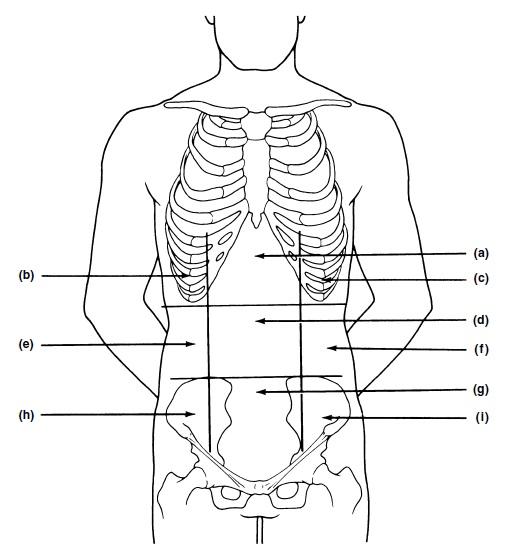
A. EPIGASTRIC REGION
B. RIGHT HYPOCHONDRIAC REGION
C. LEFT HYPOCHONDRIAC REGION
D. UMBILICAL REGION
E. RIGHT LUMBAR REGION
F. LEFT LUMBAR REGION
G. HYPOGASTRIC (PUBIC) REGION
H. RIGHT ILIAC (INGUINAL) REGION
I. LEFT ILIAC (INGUINAL) REGION
Which body cavity would have to be opened for the following types of surgery or procedures?
surgery to remove a cancerous lung lobe
THORACIC; VENTRAL
Which body cavity would have to be opened for the following types of surgery or procedures?
appendectomy
ABDOMINOPELVIC; VENTRAL
Which body cavity would have to be opened for the following types of surgery or procedures?
removal of the uterus, or womb
ABDOMINOPELVIC; VENTRAL
Which body cavity would have to be opened for the following types of surgery or procedures?
stomach ulcer operation
ABDOMINOPELVIC; VENTRAL
Which body cavity would have to be opened for the following types of surgery or procedures?
removal of a brain tumor
CRANIAL; DORSAL
Which body cavity would have to be opened for the following types of surgery or procedures?
delivery of pre-operative “saddle” anesthesia
SPINAL; DORSAL
Name the muscle that subdivides the ventral body cavity.
DIAPHRAGM
Which organ system would not be represented in any of the body cavities?
SKIN
What are the bony landmarks of the abdominopelvic cavity?
HIP BONES
Which body cavity affords the least protection to its internal structures?
ADOMINAL
What is the function of the serous membranes of the body?
THESE MEMBRANES PRODUCE A THIN LUBRICATING FLUID THAT ALLOWS THE VISCERAL ORGANS TO SLIDE OVER ONE ANOTHER OR TO RUB AGAINST HE BODY WALL WITH MINIMAL FRICTION. ALSO TO COMPARTMENTALIZE THE VARIOUS ORGANS SO THAT INFECTION OF ONE ORGAN IS PREVENTED FROM SPREADING TO OTHERS.
Using the key choices, identify the small body cavities described below.
holds the eyes in an anterior-facing position
ORBITAL
Using the key choices, identify the small body cavities described below.
contains the tongue
ORAL
Using the key choices, identify the small body cavities described below.
lines a joint cavity
SYNOVIAL
Using the key choices, identify the small body cavities described below.
houses three tiny bones involved in hearing
MIDDLE EAR
Using the key choices, identify the small body cavities described below.
contained within the nose
NASAL
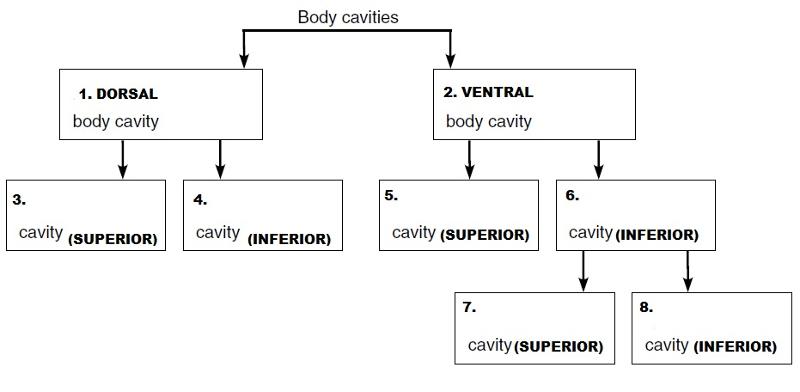
On the incomplete flow chart provided below:
• Fill in the cavity names as appropriate to each box.
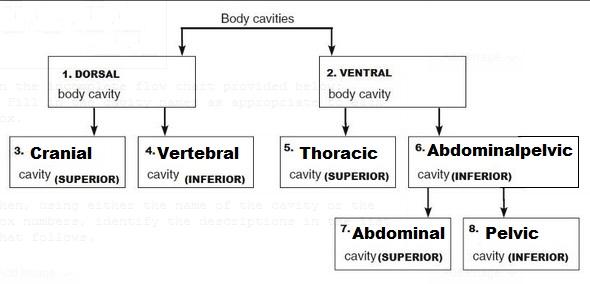
Then, using either the name of the cavity or the box numbers, identify the descriptions in the list that follows.
a. contained within the skull and vertebral column
b. contains female reproductive organs
c. the most protective body cavity
d. its name means belly
1 - a. contained within the skull and vertebral column
8 - b. contains female reproductive organs
4 - c. the most protective body cavity
7 - d. its name means belly
Then, using either the name of the cavity or the box numbers, identify the descriptions in the list that follows.
e. contains the heart
f. contains the small intestine
g. bounded by the ribs
h. its walls are muscular
5 - e. contains the heart
6 & 7 - f. contains the small intestine
5 - g. bounded by the ribs
6 & 7 - h. its walls are muscular